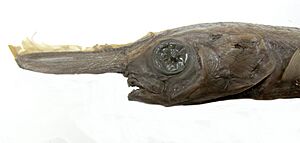Unicorn crestfish facts for kids
Quick facts for kids Unicorn crestfish |
|
|---|---|
 |
|
 |
|
| Eumecichthys fiski, conventional and X-ray images | |
| Conservation status | |
| Scientific classification | |
| Genus: |
Eumecichthys
|
| Species: |
fiski
|
| Synonyms | |
|
Lophotes fiski Günther, 1890 |
|
The unicorn crestfish, also known as Eumecichthys fiski, is a very rare and mysterious fish. It belongs to a group of fish called crestfish and is the only species in its genus, Eumecichthys. This amazing creature lives deep in the ocean, far from where most people ever go.
Contents
Discovering the Unicorn Crestfish
This unique fish was first found near Kalk Bay, South Africa. Since then, it has been spotted in many different parts of the world. These places include the Sea of Japan, off the coast of southwest Florida, near Clarion Island in Mexico, around Hawaii, and even near India. This suggests that the unicorn crestfish might live in oceans all over the globe.
Where Does It Live?
The unicorn crestfish lives in a part of the ocean called the bathypelagic zone. This is a very deep area, usually around 1,000 meters (about 3,300 feet) below the surface. It's a dark and cold place where only special creatures can survive.
What Does a Unicorn Crestfish Look Like?
The unicorn crestfish has a very unusual appearance. It has a long, flat, ribbon-like body that can grow up to 150 centimeters (about 59 inches) long. That's almost as tall as a person!
Its Unique "Horn"
Its common name, "unicorn crestfish," comes from a special horn-like part on its head. This part sticks out forward from above its eyes, making it look a bit like a unicorn.
Fins and Colors
The fish has a very long dorsal fin that runs along its entire back. The first few rays of this fin are extra long, forming a pennant-like shape. Its pectoral fins are small, and it doesn't have any pelvic fins. The anal fin is also interesting; in adult fish, it splits into two rows of small bumps.
The unicorn crestfish is mostly silvery in color. It has many dark, vertical stripes along its body, usually between 24 and 60 of them. Its dorsal and caudal fins (tail fin) are a bright crimson red, adding a splash of color to its deep-sea home.
How Does It Protect Itself?
The unicorn crestfish has a very cool and unusual defense mechanism. It's one of only three types of fish in its group that have an ink tube. This tube allows the fish to squirt out a black, inky fluid from its body. It's like a smoke screen that helps it escape from predators. This ink tube is a special part of its digestive system.
Who Are Its Predators?
Even with its ink defense, the unicorn crestfish can become prey for other deep-sea creatures. One known predator is the longnose lancetfish (Alepisaurus ferox). Scientists have found lancetfish that had swallowed unicorn crestfish, showing that these bigger fish hunt them.
Unicorn Crestfish in History
While the unicorn crestfish is rare today, it has ancient relatives. An extinct fish called Babelichthys is known from fossils found in Iran. This ancient relative lived during the Eocene epoch, millions of years ago. Studying these fossils helps scientists understand the history of these fascinating deep-sea fish.



